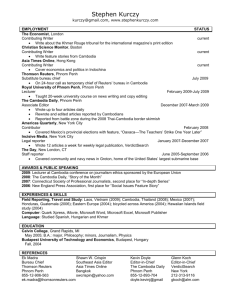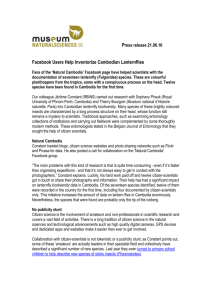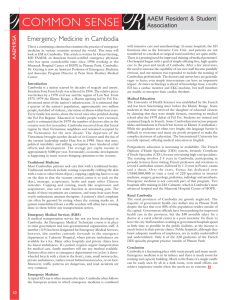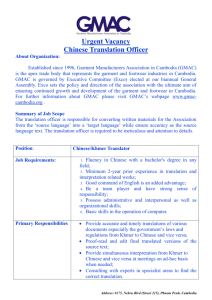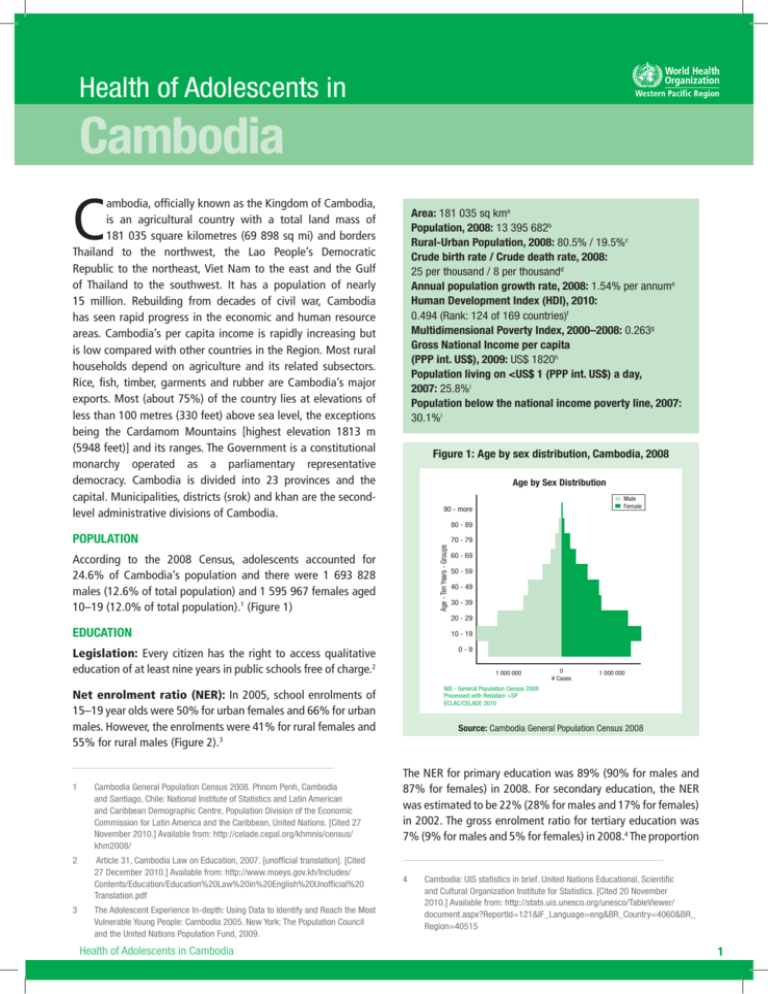
Health of Adolescents in
Cambodia
C
ambodia, officially known as the Kingdom of Cambodia,
is an agricultural country with a total land mass of
181 035 square kilometres (69 898 sq mi) and borders
Thailand to the northwest, the Lao People’s Democratic
Republic to the northeast, Viet Nam to the east and the Gulf
of Thailand to the southwest. It has a population of nearly
15 million. Rebuilding from decades of civil war, Cambodia
has seen rapid progress in the economic and human resource
areas. Cambodia’s per capita income is rapidly increasing but
is low compared with other countries in the Region. Most rural
households depend on agriculture and its related subsectors.
Rice, fish, timber, garments and rubber are Cambodia’s major
exports. Most (about 75%) of the country lies at elevations of
less than 100 metres (330 feet) above sea level, the exceptions
being the Cardamom Mountains [highest elevation 1813 m
(5948 feet)] and its ranges. The Government is a constitutional
monarchy operated as a parliamentary representative
democracy. Cambodia is divided into 23 provinces and the
capital. Municipalities, districts (srok) and khan are the secondlevel administrative divisions of Cambodia.
Area: 181 035 sq kma
Population, 2008: 13 395 682b
Rural-Urban Population, 2008: 80.5% / 19.5%c
Crude birth rate / Crude death rate, 2008:
25 per thousand / 8 per thousandd
Annual population growth rate, 2008: 1.54% per annume
Human Development Index (HDI), 2010:
0.494 (Rank: 124 of 169 countries)f
Multidimensional Poverty Index, 2000–2008: 0.263g
Gross National Income per capita
(PPP int. US$), 2009: US$ 1820h
Population living on <US$ 1 (PPP int. US$) a day,
2007: 25.8%i
Population below the national income poverty line, 2007:
30.1%i
Figure 1: Age by sex distribution, Cambodia, 2008
Age by Sex Distribution
Male
Female
90 - more
80 - 89
POPULATION
Age - Ten Years - Groups
70 - 79
According to the 2008 Census, adolescents accounted for
24.6% of Cambodia’s population and there were 1 693 828
males (12.6% of total population) and 1 595 967 females aged
10–19 (12.0% of total population).1 (Figure 1)
60 - 69
50 - 59
40 - 49
30 - 39
20 - 29
EDUCATION
10 - 19
0-9
Legislation: Every citizen has the right to access qualitative
education of at least nine years in public schools free of charge.2
1 000 000
Cambodia General Population Census 2008. Phnom Penh, Cambodia
and Santiago, Chile: National Institute of Statistics and Latin American
and Caribbean Demographic Centre, Population Division of the Economic
Commission for Latin America and the Caribbean, United Nations. [Cited 27
November 2010.] Available from: http://celade.cepal.org/khmnis/census/
khm2008/
2
Article 31, Cambodia Law on Education, 2007. [unofficial translation]. [Cited
27 December 2010.] Available from: http://www.moeys.gov.kh/Includes/
Contents/Education/Education%20Law%20in%20English%20Unofficial%20
Translation.pdf
3
The Adolescent Experience In-depth: Using Data to Identify and Reach the Most
Vulnerable Young People: Cambodia 2005. New York: The Population Council
and the United Nations Population Fund, 2009.
Health of Adolescents in Cambodia
1 000 000
NIS - General Population Census 2008
Processed with Redatam +SP
ECLAC/CELADE 2010
Net enrolment ratio (NER): In 2005, school enrolments of
15–19 year olds were 50% for urban females and 66% for urban
males. However, the enrolments were 41% for rural females and
55% for rural males (Figure 2).3
1
0
# Cases
Source: Cambodia General Population Census 2008
The NER for primary education was 89% (90% for males and
87% for females) in 2008. For secondary education, the NER
was estimated to be 22% (28% for males and 17% for females)
in 2002. The gross enrolment ratio for tertiary education was
7% (9% for males and 5% for females) in 2008.4 The proportion
4
Cambodia: UIS statistics in brief. United Nations Educational, Scientific
and Cultural Organization Institute for Statistics. [Cited 20 November
2010.] Available from: http://stats.uis.unesco.org/unesco/TableViewer/
document.aspx?ReportId=121&IF_Language=eng&BR_Country=4060&BR_
Region=40515
1
Figure 2: School enrolment among 15–19 year-olds, 2005
Urban Females
Rural Females
0%
3%
Not attending
40%
50%
26%
Not attending
Attending
primary
Attending
primary
Attending
secondary
Attending
higher
59%
Attending
secondary
Attending
higher
15%
Employment-Unemployment: Based on 2008 data, the
15–19 year old age group made up 16.4% of the country’s
labour force.10 Table 1 and Table 2 show the main activity and
employment status of adolescents aged 10–19. A total of 92
340 children aged 5–14 were employed in 2008. Computations
indicate that 0.36% of those aged 5–9, 5.2% of those aged
10–14 and 41.5% of those aged 15–19 were employed.11
7%
0%
Not attending
34%
Attending
primary
Attending
primary
45%
Main activity
22%
Source: Extracted from The Adolescent Experience In-depth: Using Data to
Identify and Reach the Most Vulnerable Young People: Cambodia 2005. New
York: The Population Council and the United Nations Population Fund, 2009.
of pupils starting grade 1 who reached the last primary level
grade was 54.4% in 2007.5
10–14
15–19
5234
87 106
672 576
Unemployed (employed
before)
77
617
3674
Unemployed (never employed
before)
-*
3090
24 594
928
6833
30 454
687 760
1 446 467
812 182
Employed
Home-maker
Student
Source: Cambodia General Population Census 2008
*No figures available were available for this category
Gender parity index (GPI): The GPI for primary level
enrolment was 0.94 in 2008; for secondary level enrolment,
the GPI was 0.82 in 2007; for the tertiary level, it was 0.54 in
2008.6
Out-of-school youth: In 2005, the percentage of 6–17 year
old girls not in school was 27.5% (28.7% in rural areas and
23.2% in urban areas) and the corresponding figure for boys
was 24.5% (25.9% in rural areas and 19.3% in urban areas);
1.3% of girls and 1.0% of boys aged 10–14 were neither in
school nor living with either parent.7
ECONOMICS
Legislation: The Labour Law establishes 15 years as the
minimum age for employment and 18 years as the minimum
age for hazardous work. Children aged 12-15 can engage in
“light work” if it is not hazardous to their health and does not
affect school attendance.8
Labour force participation: Based on 2007 data,
the labour force was made up of 7 844 000 people of
10 454 000 people of working age. The labour force
participation rate for adolescents aged 10–14 was 44% and
71% for those aged 15–19.9
5
Cambodia country data. Millennium Development Goals Indicators. United
Nations Statistics Division, Department of Economic and Social Affairs,
United Nations. [Updated 23 June 2010, cited 6 November 2010.] Available
from: http://mdgs.un.org/unsd/mdg/Data.aspx
Table 2: Employment Status of Youth Aged 10–19, 2008
8
9
2
The Adolescent Experience In-depth: Using Data to Identify and Reach the
Most Vulnerable Young People: Cambodia 2005. New York: The Population
Council and the United Nations Population Fund, 2009.
Cambodia Human Rights Report: Status of Child Labor Practices and
Minimum Age for Employment. [Cited 6 November 2010.] Available
from: http://www.ncbuy.com/reference/country/humanrights.
html?code=cb&sec=6d
Labour force 2007. Report based on the Cambodia Socio-Economic Survey.
Phnom Penh, Cambodia: National Institute of Statistics, Ministry of Planning,
2010.
Employment Status
Male
Female
Paid Employee
60 517
97 428
Own Account Worker
38 609
23 293
Unpaid Family Worker
261 500
280 903
Others
763
157
Source: Cambodia General Population Census 2008
Migrant labour force: In 2004, the number of beyondprovince labour migrants was 257 903. In 2006, 330 000
workers employed in the garment industry were young women
from rural areas; construction produced 260 000 jobs for
young men; and hotels and restaurants produced 61 000 jobs.
Overall, 77.3% of youth migrant workers worked seven days a
week and an average of 10.6 hours a day.12
SEXUAL AND REPRODUCTIVE HEALTH
Legislation: (i) There is no legally defined or statutory age
of consent to sexual intercourse under Cambodian law.13
10
Situation Analysis of Youth in Cambodia. Phnom Penh, Cambodia: United
Nations Country Team, 2009.
11
Cambodia General Population Census 2008. Phnom Penh, Cambodia
and Santiago, Chile: National Institute of Statistics and Latin American
and Caribbean Demographic Centre, Population Division of the Economic
Commission for Latin America and the Caribbean, United Nations. [Cited 27
November 2010.] Available from: http://celade.cepal.org/khmnis/census/
khm2008/
12
Youth Migration and Urbanisation in Cambodia. Working Paper 36. Paper
Commissioned by United Nations Population Fund, Cambodia. Cambodia’s
Leading Independent Development Policy Research Institute, 2007.
13
A study on Cambodia’s criminal justice system with focus on prosecuting
foreign child sex offenders. Action pour les enfants, 2006. [Updated
28 November 2009, cited 27 December 2010.] Available from: http://
www.aplecambodia.org/images/reportresearch/A%20study%20on%20
Cambodia%27s%20criminal%20justice%20system.pdf
6Ibid.
7
Age
5–9
Attending
secondary
Attending
higher
Attending
higher
14%
Not attending
33%
Attending
secondary
51%
Table 1: Main activity of youth by age, 2008
Rural Males
Urban Males
1%
Health of Adolescents in Cambodia
(ii) The Law on Marriage and Family states that a marriage
may be permitted for a male who is 20 years old or more
and a female who is 18 years or more. However, in special
cases where a male or female have not reached these ages, a
marriage may be legitimized upon consent by the parents or
guardians or if the female becomes pregnant. (iii) The Abortion
Law states that abortion is permitted for pregnancies of less
than 12 weeks. However, it is permitted after 12 weeks if the
pregnancy is abnormal, it causes a risk to the female’s life or if
she has been raped, provided the female is more than 18 years
old or it is requested by her parents if she is under 18.14
Sexual behaviour: The 2005 Demographic and Health
Survey (DHS) found that the median age at first intercourse
was 20.4 years for women, 21.5 years for men, 21.1 years for
urban residents and 20.3 years for rural residents.15
In the Most at Risk Young People Survey 2010 (MARYP 2010),
18.5% of male respondents aged 10–19 and 8.8% of female
respondents aged 10–19 had ever had sex. Among sexually
active adolescents aged 10–19, the median age at first sexual
intercourse was 18 for males and 17 for females.16 17
For the majority of male respondents aged 10–19 who had
had sex, their first sexual partner was their girlfriend or
sweetheart (66.5%), followed sex workers (11.7%). In the past
12 months, their sexual partners were mainly their girlfriends
or sweethearts (56.1%), followed by karaoke workers (22.2%)
and brothel or street-based sex workers (21.0%). In the past 12
months, 44.5% reported having had sex with their girlfriend,
of whom 66.6% said that in the past three months they had
always used a condom.18
Among female respondents aged 10–19 who had had sex,
51.8% stated that their first sexual partner was their boyfriend
or sweetheart followed by 31.9% who mentioned their
husband. In the past 12 months, 10.2% reported having had
sex with their boyfriend, of whom 25.6% said that in the past
three months they had always used a condom.19
Of the sexually active respondents aged 10–19, 0.37% of
females and 0.72% of males reported that they were forced to
have sex in the past 12 months.20
Other findings from the Cambodia Demographic
and Health Survey 2005 (CDHS 2005)17:
• Among women aged 15–19, 3% had forced first sexual
intercourse.
• Among adolescents aged 15–19, 0.7% of females and
0.4% of males reported experiencing their first sexual
intercourse at age 15.
• Among all female adolescents aged 15–19, 8.3% had had
sexual intercourse within the past four weeks and 2.2%
within the past year.
• Among the never-married adolescents aged 15–19, 0.1%
of females and 3.6% of males reported having had sexual
intercourse in the past 12 months.
• Fully 81.9% of the never-married men aged 15–19 who
had sexual intercourse in the past 12 months reported
using a condom at last sexual intercourse.
• Among female adolescents aged 15–19 who were sexually
active in the past year, 1.2% had higher-risk intercourse.
• Among male adolescents aged 15–19 who were sexually
active in the past year, 69.8% had higher-risk intercourse,
of whom 80.2% reported condom use when doing so.
Commercial or transactional sex: In the 2005
Demographic Health Survey (DHS), of 1662 males aged
15–19, 2.5% said that they had paid for sexual intercourse
in the past 12 months and 99.8% of them reported condom
use.21
In MARYP 2010, 83.35% of sexually active male respondents
aged 10–19 reported ever paying for sex with women in the
past year, 92.61% of whom said that they had always used a
condom when doing so in the last three months. Among the
sexually active female respondents aged 10–19, 36.75% were
ever paid for sex in the past year, 92.49% of whom had used
condom the last time they had sex with a client.22
Marriage: The 2005 DHS found that the median age for first
marriage was 20 for women and 22 for men.23 The singulate
mean age at marriage was 25.6 for men and 23.3 for women.24
Among female adolescents aged 15–19, 10.1% were currently
married or in union, 0.8% were separated, divorced or widowed
and 89.2% were never married. Among the male adolescents,
1.6% were currently married and 0.4% were separated.25
14
Cambodia: Abortion Law, 1997. [Informally translated]. [Cited 27 December
2010.] Available from: http://rc.racha.org.kh/download.asp?file=/resources/
documents/1-100/1-20/5/AbortionLaw.doc
21
15
Cambodia: Demographic and Health Survey 2005. Phnom Penh, Cambodia
and Calverton, Maryland, United States of America: National Institute of
Public Health, National Institute of Statistics and ORC Macro, 2006.
Cambodia: Demographic and Health Survey 2005. Phnom Penh, Cambodia
and Calverton, Maryland, United States of America: National Institute of
Public Health, National Institute of Statistics and ORC Macro, 2006.
22
Cambodia Most at Risk Young People Survey 2010. [Updated July 2010.]
23
Cambodia: Demographic and Health Survey 2005. Phnom Penh, Cambodia
and Calverton, Maryland, United States of America: National Institute of
Public Health, National Institute of Statistics and ORC Macro, 2006.
24
Cambodia General Population Census 2008: Final Census results—Figures
at a glance. Phnom Penh, Cambodia: National Institute of Statistics. [Cited
27 November 2010.] Available from: http://celade.cepal.org/khmnis/census/
khm2008/
25
Cambodia: Demographic and Health Survey 2005. Phnom Penh, Cambodia
and Calverton, Maryland, United States of America: National Institute of
Public Health, National Institute of Statistics and ORC Macro, 2006.
16
Cambodia Most at Risk Young People Survey 2010. [Updated July 2010.]
17
Cambodia: Demographic and Health Survey 2005. Phnom Penh, Cambodia
and Calverton, Maryland, United States of America: National Institute of
Public Health, National Institute of Statistics and ORC Macro, 2006
18Ibid.
19Ibid.
20Ibid.
Health of Adolescents in Cambodia
3
Findings from the 2005 DHS 27
Of the 3601 female adolescents aged 15-19,
• 2.5% have ever used any modern method (1.5% pill and
0.9% male condom)
• 1.4% are current users of any modern method (0.7% pill
and 0.3% male condom)
Of the 363 currently married female adolescents,
• 97.3% reported having knowledge of any modern
contraceptive method
• 24.1% had ever used any modern method (14.4% pill and
7.9% male condom)
• 13.7% were current users of any modern method (7.0%
pill and 2.8% male condom)
child while 0.4% had two. Of the currently married female
adolescents, 44.7% had one child, 3.7% had two and 0.5%
had four children. Fully 6% of urban girls and 8% of rural girls
had begun childbearing before age 20. One in five adolescents
who had never been to school had begun child-bearing
compared with one in 10 who had primary school education
and less than one in 20 with secondary or higher education.29
Among adolescents aged 15-19, almost 7% of those aged 19
were pregnant with their first child. (Figure 4)
Figure 4: Adolescent pregnancy by age, 2005
7
% of women aged 15-19 with their first child
Contraceptive knowledge and use: Among female
adolescents aged 10–19 in MARYP 2010, 41.2% knew of
condoms, 19.6% knew of the pill, 1.0% knew of injectable
methods and 5.9% knew of withdrawal as birth spacing
methods. Among male adolescents aged 10–19, 81.6% knew
of the pill, 71.9% knew of the condom and 60.2% knew of the
IUD as birth spacing methods.26 27
6.6
6
5
4.3
4
3
2.4
2
1.2
1
0
0
15
Figure 3 shows the current use of modern contraceptives by
age among female respondents in the 2005 DHS.
% of currently married women using modern contraceptives
Figure 3: Use of modern contraceptives among currently
married women by age, 2005
40
17
18
19
Age
Source: Extracted from Cambodia country profile. Department of Making
Pregnancy Safer, World Health Organization. [cited 12 November 2010].
Available from: http://www.who.int/making_pregnancy_safer/countries/cam.pdf
Among female respondents aged 10–19 in MARYP 2010 who
had ever got pregnant, 5.9% were still pregnant, 26.6% had
had a live birth and 22.1% had a miscarriage.30
35
30
Adolescent birth rate: The age-specific fertility rate
reported for adolescents aged 15–19 was 47 per thousand
women (urban=32 and rural=51).31 32
28.4
27.9
25
23.4
22.1
20
15
12.9
10
9.4
5
0
1.4
15-19
20-24
25-29
30-34
35-39
40-44
45-49
Age in 5 year categories
Source: Extracted from Cambodia country profile. Department of Making
Pregnancy Safer, World Health Organization. [cited 12 November 2010].
Available from: http://www.who.int/making_pregnancy_safer/countries/cam.pdf
In the MARYP 2010, at last sex with their sweetheart, 36.85%
of females and 65.5% of males aged 10–19 mentioned that
they used a condom.28
Childbearing: The 2005 DHS found that among female
adolescents aged 15–19, about 8% had become mothers or
were currently pregnant with their first child; 4.8% had one
4
16
Neonatal, post-neonatal and infant mortality:
The relationship between maternal age at birth and childhood
mortality is generally a U-shaped curve. Among mothers under
20 years old at the birth of child, the neonatal mortality rate
was 48, post-neonatal mortality was 37, infant mortality was
85, child mortality was 13 and under-5 mortality was 98 per
thousand births.33
Abortion: The 2005 DHS showed that 0.3% of females
aged 15–19 had had one abortion while 0.1% had had three
abortions during their lifetime.34
29
Cambodia: Demographic and Health Survey 2005. Phnom Penh, Cambodia
and Calverton, Maryland, United States of America: National Institute of
Public Health, National Institute of Statistics and ORC Macro, 2006.
30
Cambodia Most at Risk Young People Survey 2010. [Updated July 2010.]
31
Cambodia: Demographic and Health Survey 2005. Phnom Penh, Cambodia
and Calverton, Maryland, United States of America: National Institute of
Public Health, National Institute of Statistics and ORC Macro, 2006.
26
Cambodia Most at Risk Young People Survey 2010. [updated 2010 July]
27
Cambodia: Demographic and Health Survey 2005. Phnom Penh, Cambodia
and Calverton, Maryland, United States of America: National Institute of
Public Health, National Institute of Statistics and ORC Macro, 2006.
32Ibid.
28
Cambodia Most at Risk Young People Survey 2010. [Updated July 2010.]
34Ibid.
33Ibid.
Health of Adolescents in Cambodia
Findings from the 2005 DHS32 on maternal health:
Among mothers under 20 years old:
• 6.8% had received antenatal care coverage from doctors,
3.1% from nurses, 58.9% from midwives and 3% from
traditional birth attendants.
• Among those with a live birth in the past five years, 61.2%
had taken iron tablets or syrup, 56.3% had received
two or more tetanus toxoid injections (TTI) during the
last pregnancy while 9.9% had received one TTI and an
additional one before the pregnancy.
• 16.3% had given birth at a health facility in the public
sector, 5.5% in a private sector health facility and 78.2%
at home.
• During delivery, 6.4% had received assistance from a
doctor, 1.6% from a nurse, 36.2% from a midwife, 55.5%
from a traditional birth attendant and 0.2% from a relative.
• Among currently married adolescents aged 15-19, 23.5%
had unmet need for spacing and 2.2% had unmet need for
limiting births.
• Among adolescents aged 15-19, during the period 0-6
years before the survey, there were five maternal deaths.
The maternal mortality rate was 0.13 per thousand
women-years of exposure.
Among sexually active female respondents aged 10–19 in
MARYP 2010, 3.52% reported ever being pregnant, of whom
45.28% had had their last pregnancy terminated by induced
abortion.35
Sexually Transmitted Infections (STIs): In the 2005 DHS,
among the 392 female respondents aged 15–19 who ever had
sexual intercourse, 5.5% reported having an STI in the past
12 months. However, none among the 105 male respondents
aged 15–19 who ever had sexual intercourse reported having
an STI.36
Among the sexually active respondents in the MARYP 2010,
17.8% of females and 1.3% of males reported discharge with
an unpleasant odor; 1.4% of females and 1.7% of males
reported cuts or sores in the genital area; and 1.6% of females
and 0.9% of males reported swelling in the genital area in the
past 12 months. However, 42.8% of females and 29.1% of
males did not seek treatment.37
Among female respondents aged 10-19 who sought STI
treatment, 10.1% experienced stigma and discrimination
during the last treatment session.38
HIV prevalence and infection: In the 2005 DHS, among
youth who were tested for HIV, 0% of females and 0.1%
35
Cambodia Most at Risk Young People Survey 2010. [Updated July 2010.]
36
Cambodia: Demographic and Health Survey 2005. Phnom Penh, Cambodia
and Calverton, Maryland, United States of America: National Institute of
Public Health, National Institute of Statistics and ORC Macro, 2006.
37
Cambodia Most at Risk Young People Survey 2010. [Updated July 2010.]
38
Cambodia Most at Risk Young People Survey 2010. [Updated July 2010.]
Health of Adolescents in Cambodia
of males aged 15–19 were HIV-positive.39 In 2006, among
young pregnant women aged 15–24, HIV prevalence was
0.4%. Nearly half of new infections were occurring in married
women, most of who were infected by their husbands.40
HIV knowledge and education: The 2005 DHS also found
that 98.3% of men and 98.2% of women aged 15–19 had
heard of AIDS; 50.2% of female adolescents and 41.4% of
male adolescents had a comprehensive knowledge of AIDS.41
The School Health Department of the Ministry of Education,
Youth and Sports reported that from September 2008 to June
2009, 34.1% (2738 schools) of all primary and secondary
schools provided life skills-based HIV education. In the 20082009 school year, 5.2% of secondary schools and 40.6% of
primary schools, in 14 out of 24 provinces and municipalities,
provided life skills-based HIV education.42
Health care-seeking behaviour and knowledge: The
2005 DHS found that 92.6% of females aged 15-19 had at
least one problem accessing health care, with 75% of them
being unable to get the money needed for treatment.43
In MARYP 2010, the two main barriers that prevented the most
at-risk adolescents aged 10–19 from using health services was
fear that confidentiality is not maintained (58.1%) and the
service fee (15.9%).44
Adolescent-Friendly
Health
Services
(AFHS):
The Reproductive Health Association of Cambodia (RHAC),
established in 1996, has been implementing the Adolescent
HIV/AIDS and Reproductive Health Project since mid-1997. This
project covers about 615 000 young people aged 10–24 in 1312
villages and 43 schools. In order to communicate reproductive
health messages and information to young people, the project
uses peer educators, group discussions, one-on-one talks, local
theatre or quiz shows, village edutainment quizzes, mobile
videos, educational materials and youth centres. In 2007, the
project had 2892 trained peer educators, distributed 203 619
condoms and offered STI services to 48 732 youth under 25
39
Cambodia: Demographic and Health Survey 2005. Phnom Penh, Cambodia
and Calverton, Maryland, United States of America: National Institute of
Public Health, National Institute of Statistics and ORC Macro, 2006.
40
Situation Analysis of Youth in Cambodia. Phnom Penh, Cambodia: United
Nations Country Team, 2009.
41
Cambodia: Demographic and Health Survey 2005. Phnom Penh, Cambodia
and Calverton, Maryland, United States of America: National Institute of
Public Health, National Institute of Statistics and ORC Macro, 2006.
42
Cambodia: Country Progress Report: Monitoring the progress towards
the implementation of the Declaration of Commitment on HIV and AIDS.
Reporting Period: January 2008-December 2009. The National AIDS
Authority, 2010. Available from: http://data.unaids.org/pub/Report/2010/
cambodia_2010_country_progress_report_en.pdf
43
Cambodia: Demographic and Health Survey 2005. Phnom Penh, Cambodia
and Calverton, Maryland, United States of America: National Institute of
Public Health, National Institute of Statistics and ORC Macro, 2006.
44
Cambodia Most at Risk Young People Survey 2010. [Updated July 2010.]
5
years old.45 In 2010, RHAC worked with 49 health centres on
youth-friendly services with 18 RHAC clinics providing AFHS.46
with 0.6%). Generally, the majority started smoking when they
were 15 years old.51
The European Union/United Nations Population Fund
Reproductive Health Initiative in Asia (RHIYA), launched in
2003, has seven projects in 11 provinces targeted at improving
sexual and reproductive health of young people aged 10–24.
RHIYA has 16 local and three European NGOs who carry out
their activities, which include peer education and outreach
through educational materials, radio programmes, theatre and
sports. Over 600 000 peer educator contacts were made, 140
000 young Cambodians were registered as clients at service
delivery points and more than 1100 advocacy events have
been undertaken.47
Table 3 shows results from the Global Youth Tobacco Survey
2003. Among students aged 13–15, 5.5% currently smoke
cigarettes (7.9% of boys and 1.0% of girls) and 4.2% currently
used tobacco products other than cigarettes (4.8% of boys and
2.5% of girls). More than half were also exposed to secondhand smoke at home.52
NUTRITION STATUS
The 2005 DHS revealed that 11.3% of females aged 15–19
were less than 145 cm in height; 8.6% had a Body Mass Index
(BMI) of <17 ( (moderately and severely thin) while 1.5% had
a BMI of >25 (overweight or obese).48
MENTAL HEALTH
A National Institute of Statistics/National Institute of Public
Health survey observed that suicide was a leading cause of
death among adolescents aged 15–17. Focus group discussions
suggest that mental health issues stem from violence in the
home, a perceived lack of caring from the family, feelings of
isolation and involvement in an abusive relationship.49
SUBSTANCE USE
Legislation: There is no legislation which stipulates the
minimum age for purchase of tobacco and alcohol.
Tobacco use: Among adolescents aged 15–19, 2.9% of males
and females reported having smoked a cigarette. Of these,
5.1% of males and 0.6% of females said that they smoked
daily. More rural adolescents smoked (3.3%) compared with
those in urban areas (2%).50
The 2004 Youth Risk Behaviour Survey (YRBS) reported that 5%
of adolescents aged 11–18 had tried smoking and more than
half reported smoking daily. Out-of-school youths also were
more likely to smoke than those in school (9.2% compared
Main activity
Students aged 13–15 (%)
Total
Male
Female
Percentage who currently smoked
cigarettes
5.5
7.9
1.0
Percentage who currently used
tobacco products other than cigarettes
4.2
4.8
2.5
Percentage who lived in homes where
others smoked in their presence
50.6
-
-
Percentage who tried to stop smoking
(among current smokers)
80.7
-
-
Source: Cambodia: Global Youth Tobacco Survey, 2003
Alcohol use: The MARYP 2010 found that 70% of the female
and 91% of male respondents reported drinking alcohol
for reasons such as a way of socializing with their peers,
celebration, coping with stress and to look fashionable or
wealthy. The median age at first drinking of alcohol among
those aged 10–19 was 17 years for females and 16 years for
males. Among respondents aged 10–19, 57.6% of females
and 81.44% of males had ever consumed alcohol; 8.09% of
females and 1.11% of males identified themselves as heavy
drinkers. This higher number of heavy female drinkers may be
related to many working in karaoke or nightclubs, where they
are required to drink with their customers.53
Among MARYP 2010 respondents aged 10–19 who ever had
sex, 89.2% of females and 99.3% of males had ever consumed
alcohol compared with 54.6% of females and 77.4% of males
aged 10–19 who never had sex.54
Illicit drug use: Youth aged 10–25 appeared to account for
almost 80% of known illicit substance users; 60% were in the
18–25 age group and 17% were aged 10–17.55 In 2007, of
45
Reproductive Health Association of Cambodia (RHAC). [Cited 26 December
2010.] Available from: http://www.rhac.org.kh/project_category.php?cat=7
46
Email correspondence between Dr Var Chivorn of Reproductive Health
Association of Cambodia and Dr Kannitha Cheang, National Professional
Officer, Making Pregnancy Safer, World Health Organization Representative
Office in Cambodia. [Updated 16 December 2010.]
47
Cambodia: Overview. European Union/United Nations Population
Fund Reproductive Health Initiative in Asia (RHIYA). [Cited 26
December 2010.] Available from: http://www.rhiya.org/cambodia.
php?area=2&page=2&option=1
52
The Global Youth Tobacco Survey 2003: Cambodia, [Cited 6 November 2010.]
Available from: http://www.wpro.who.int/NR/rdonlyres/67D1388A-CF294EC7-A104-132C46704556/0/CambodiaFACTSHEETGYTS.pdf
53
Cambodia Most at Risk Young People Survey 2010. [Updated July 2010.]
48
Cambodia: Demographic and Health Survey 2005. Phnom Penh, Cambodia
and Calverton, Maryland, United States of America: National Institute of
Public Health, National Institute of Statistics and ORC Macro, 2006.
54Ibid.
49
Situation Analysis of Youth in Cambodia. Phnom Penh, Cambodia: United
Nations Country Team, 2009.
50Ibid.
6
Table 3: Results from Cambodia Global Youth Tobacco
Survey, 2003
51Ibid.
55
John Howard, Hammad Ali, Lisa Robins, National Drug and Alcohol
Research Centre, University of New South Wales, Sydney Australia. Review
of Adolescent Substance Use and Responses in the WHO Western Pacific
Region. Report prepared for the World Health Organization Regional Office for
the Western Pacific, May 2010. [unpublished]
Health of Adolescents in Cambodia
2089 street children and youth surveyed, 50% reported recent
use of at least one illicit drug (58% of males and 30% of
females). About two thirds of street adolescents aged 16–18
used illicit substances compared with one third of those aged
12–15 years.56
The MARYP 2010 found that among adolescents aged 10–19,
9.3% of males and 1.9% of females reported ever using drugs.
The average age of first drug use was 17 years for both males
and females aged 10–19. Drug use was higher among the
older age group 20–24 years and among those living in urban
areas. Among female adolescents aged 10–19 who had ever
used drugs in the past six months, the most common drug
used was yama and yaba (31.4%) followed by ice or methbased powder (20.6%); among males, it was ice or methbased powder (32.1%) followed by yama and yaba (24.2%).57
Among MARYP 2010 respondents aged 10–19 who ever had
sex, 17.8% of females and 27.5% of males had ever used
drugs compared to 0.4% of females and 5.3% of males aged
10–19 who never had sex.58
VIOLENCE AND INJURIES
Domestic violence: According to the 2005 DHS, 20.6% of
ever-married females aged 15–19 had experienced violence
since age 15; 7.9% had experienced violence in the past 12
months and 1.7% had experienced violence during pregnancy.
Among ever- married females aged 15–19, 14.2% reported
emotional violence, 6.4% physical violence and 1.9% sexual
violence by their spouse.59
Accidental injuries and deaths: The 2005 DHS reported
that 291 adolescents aged 10–19 were injured or killed in an
accident in the past 12 months. Of these, 34.3% were from
a road accident, 22.9% from a fall, 5.5% from a snake or an
animal bite, 2.9% from violence, 1.8% from gunshot, 1.1%
from drowning, 1.1% from chemical poisoning, 0.8% from
severe burns, 0.3% from a landmine or an unexploded bomb
and 28.7% from other causes.60
Health and Welfare
• Policy on Alternative Care for Children, 2006
• Law on the Prevention and Combat against the Spread of
HIV/AIDS, 2002
• Guidelines on the Establishment of the Commune/Sangkat
Committees for Women and Children, 2002
Sexual and Reproductive Health
• Law on Marriage and Family, 1989
• Abortion Law, 1997
Substance Use
• Law on Drugs Control, 1996
Crimes, Violence and Injuries
• Law on the Suppression of Human Trafficking and Sexual
Exploitation, 2007
• Law on Prevention of Domestic Violence and Protection of
Victims, 2005
• Law on Sex Trafficking, 1997
• Law on Suppression of the Kidnapping and Trafficking of
Human Persons and Exploitation of Human Persons, 1996
Conventions
• International Labor Organization’s (ILO) Convention No 182
on the Worst Forms of Child Labor, 2006
• World Health Organization Framework Convention on
Tobacco Control, 2003
• United Nations Convention on the Elimination of All Forms of
Discrimination Against Women, 2001
• The Protocol to Prevent, Suppress and Punish Trafficking in
Persons, Especially Women and Children, 2001
• The Optional Protocol on the Sale of Children, Child
Prostitution and Child Pornography, 2000
• The Stockholm Declaration and Agenda for Action, 1996
• Convention on the Rights of a Child, 1992
LIST OF LEGISLATION WHICH IMPACT ON ADOLESCENT
HEALTH AND WELL-BEING
• ILO’s Minimum Age Convention No. 138, 1973
Employment
Note: This is not meant to be a comprehensive list of all relevant
government initiatives.
• Labour Law, 1998
Education
• Law on Education, 2007
GOVERNMENT RESPONSE
Employment
• Decent Work Corporation Framework, 2010–2012
• Rectangular Strategy for Growth, Employment, Equity and
Efficiency, 2004
56Ibid.
• National Strategic Development Plan, 2006–2010
57
• Socio-Economic Development Plan, 2001–2005
Cambodia Most at Risk Young People Survey 2010. [Updated July 2010.]
58Ibid.
59
Cambodia: Demographic and Health Survey 2005. Phnom Penh, Cambodia
and Calverton, Maryland, United States of America: National Institute of
Public Health, National Institute of Statistics and ORC Macro, 2006.
• National Poverty Reduction Strategy, 2003–2005
• Cambodia Millennium Development Goals 2015
60Ibid.
Health of Adolescents in Cambodia
7
Education
• Cambodia HIV/AIDS Strategic Plan, 2002–2005
• UNESCO National Education Support Strategy, 2010–2013
• Education Strategic Plan, 2006 –2010
• National Strategic Plan for a Comprehensive and
Multisectoral Response to HIV/AIDS, 2006–2010
• Education Sector Support Programme, 2006–2010
• Pact Cambodia AIDS Programme, 2002
• Education for All National Plan 2003–2015
• United States Agency for International Development
(USAID)-funded Improved Basic Education Programme
• USAID-funded Educational Support for Children in
Underserved Populations, 2005–2008
Nutrition and physical activity
• Cambodia Nutrition Investment Plan, 2003–2007
• National Nutrition Strategy, 2009–2015
• Strategic Framework for Food Security and Nutrition
• Schools for Life Programme, 2008–2009
• Cambodia Child Survival Strategy
• Cambodia Educational Media Initiative
Mental Health
Health
• Cambodian National Health Plan, 1993
• Green Health Project, 2006
• National Mental Health Projects, 1994
• Siam Reap – Angkor Declaration – “Towards a Region
Where Every Child Counts”, 2005
• Cambodian Mental Health Development Programme
• Health Initiatives Fund, 2001
• Cambodian-German Development Cooperation, Strategy
for the Priority Area of Health
• Master Plan for Social Health Insurance, 2003–2005
• Strategic Framework for Health Financing
Sexual and Reproductive Health
• National Strategy for Reproductive and Sexual Health,
2006–2010
• Reproductive Health Initiative for Youth in Asia
• Youth for Youth: Peer Education
• Cambodia Youth Camp
• MoEYS HIV/ Life Skills for HIV/AIDS Education Programme
for In and Out of School Youth, 2005–2007
• Vulnerable Street Children Programme, 2005–2007
• HIV/AIDS Prevention – Promoting Healthy Youth, 2005
• HIV/AIDS Education for Youth Project, 2000–2005
• Cambodian National Program for Mental Health
Substance Abuse
• Five-Year National Plan on Drugs Control 2005–2010
• Narcotics Control Strategy
• Cambodia Movement for Health Project
Crime, Injuries and violence prevention
• OPTIONS: Combating Child Trafficking and Exploitation
through Education, 2003–2007
• Cambodia Criminal Justice Assistance Project, 1997–2012
• Combating Domestic Violence in Cambodia: Public
Education Through Street Theatre
• National Road Safety Policy
• Road Traffic Law, 2007
• Road Safety Action Plan, 2006–2010
• Action Plan for Violence Prevention, 2007–2010
• Injury and Violence Prevention Strategic Plan, 2008–2018
Sources:
8
a.
Cambodia: Demographic and Health Survey 2005. Phnom Penh, Cambodia and Calverton, Maryland, United States of America: National Institute of Public Health,
National Institute of Statistics and ORC Macro, 2006.
b.
National Institute of Statistics, Ministry of Planning, Cambodia. Home Page: Quick figures. [Cited 6 November 2010.] Available from: http://www.nis.gov.kh/
c.
General Population Census of Cambodia 2008. Cambodia: National Institute of Statistics, Ministry of Planning. Available from: http://www.nis.gov.kh/nis//census2008//
Census.pdf
d.
Cambodia Statistics. United Nations Children’s Fund. [Updated 2 March 2010, cited 1 November 2010.] Available from: http://www.unicef.org/infobycountry/cambodia_
statistics.html
e.
National Institute of Statistics, Ministry of Planning, Cambodia. Home Page: Quick figures. [Cited 6 November 2010.] Available from: http://www.nis.gov.kh/
f.
Human Development Report 2010. Table 2: Human Development Index Trends, 1980-2010. United Nations Development Programme. Available from: http://hdr.undp.
org/en/media/HDR_2010_EN_Table2.pdf
g.
Human Development Report 2010. Table 5: Multidimensional Poverty Index. United Nations Development Programme. [Cited 6 November 2010.] Available from: http://
hdr.undp.org/en/media/HDR_2010_EN_Table5.pdf
h.
Gross national income per capita 2009, Atlas method and PPP. World Development Indicators Database, World Bank. [Updated 14 April 2011, cited 15 May 2011.]
Available from: http://siteresources.worldbank.org/DATASTATISTICS/Resources/GNIPC.pdf
i.
Cambodia country data. Millennium Development Goals Indicators. United Nations Statistics Division, Department of Economic and Social Affairs, United Nations.
[Updated 23 June 2010, cited 6 November 2010.] Available from: http://mdgs.un.org/unsd/mdg/Data.aspx
Health of Adolescents in Cambodia


